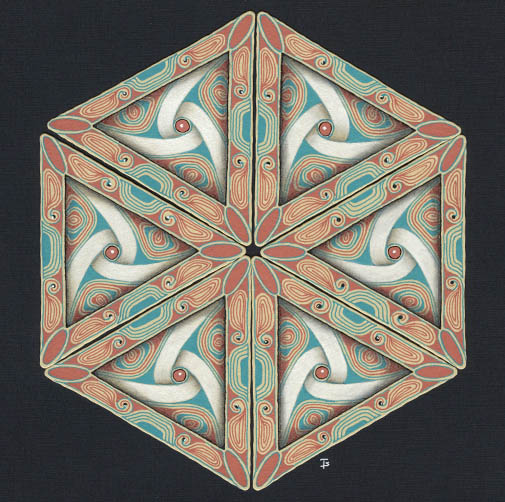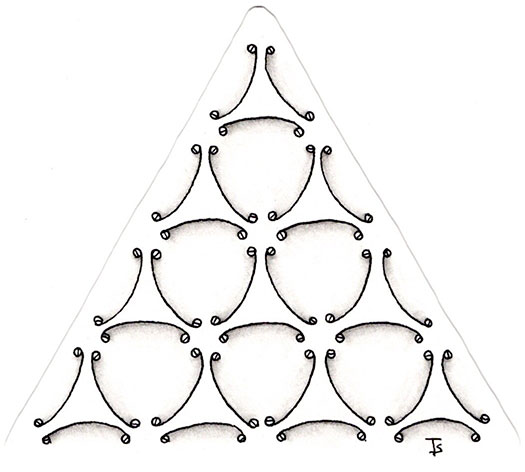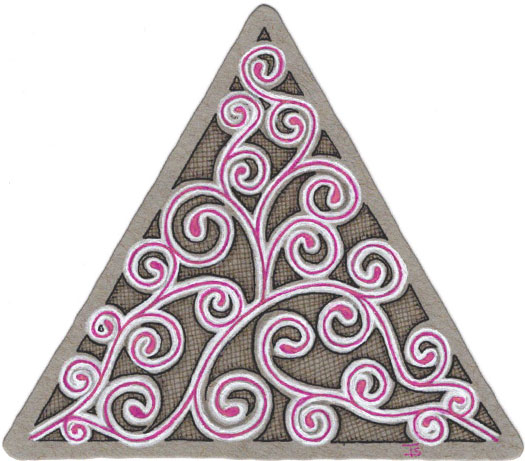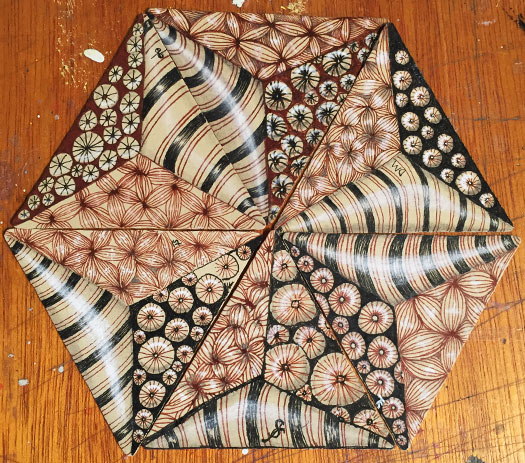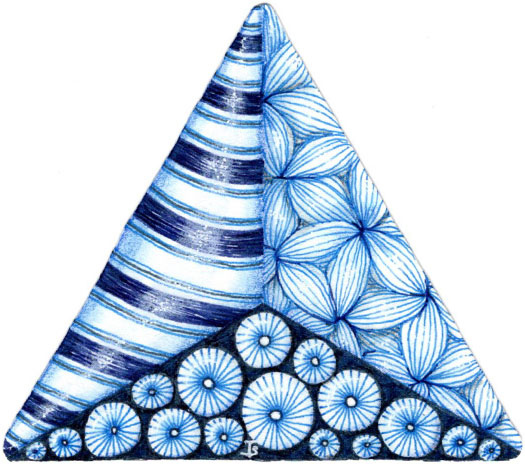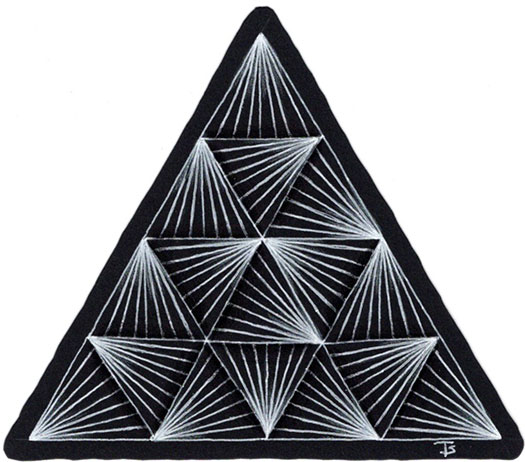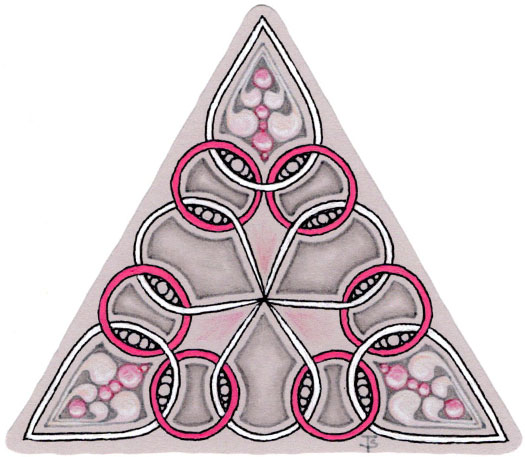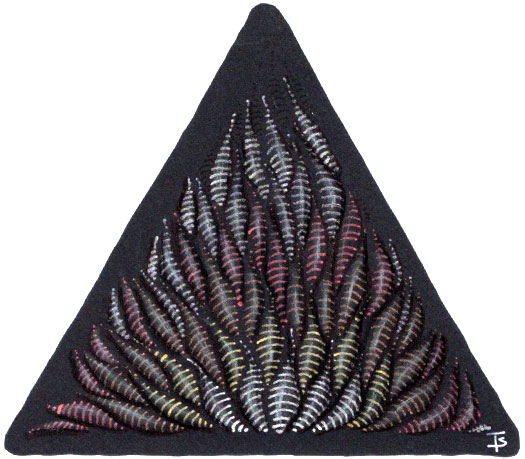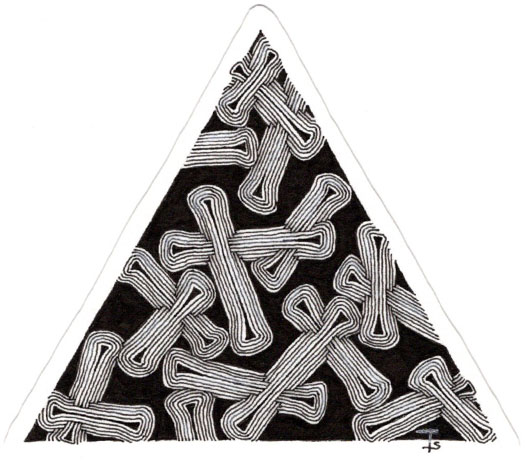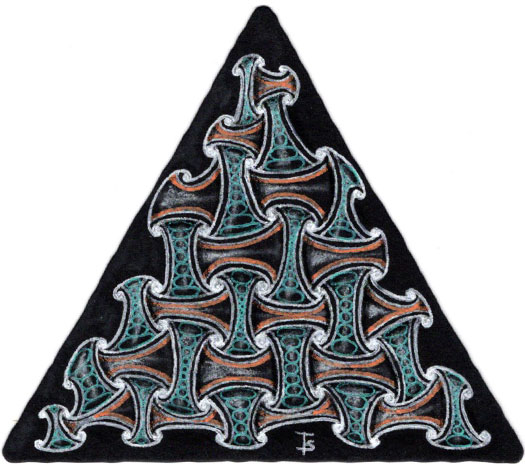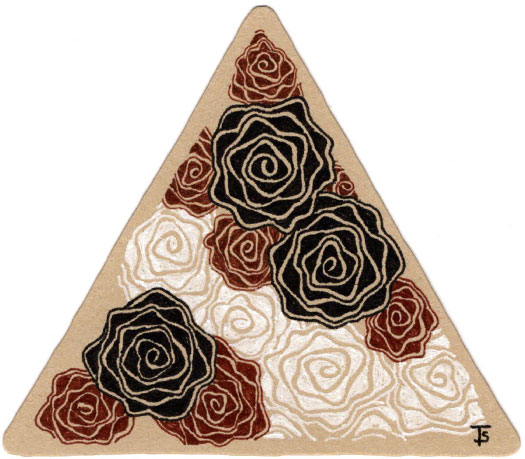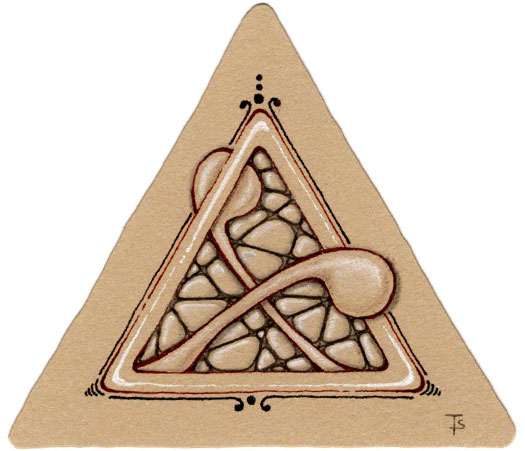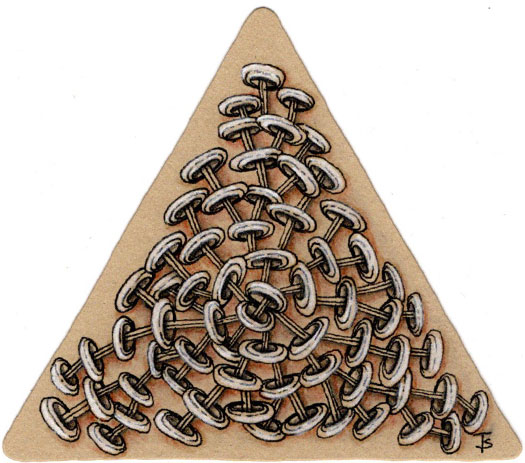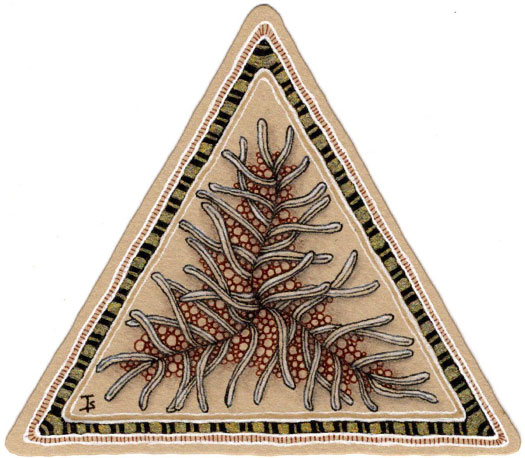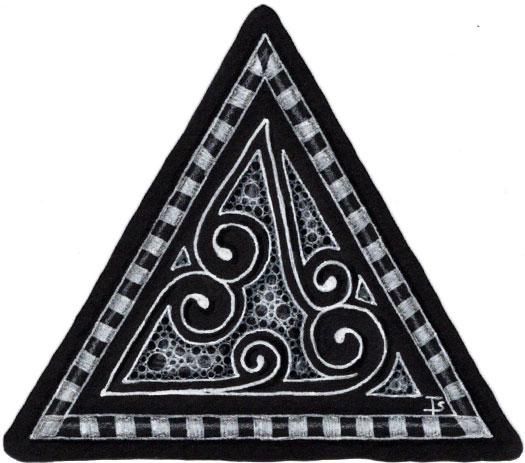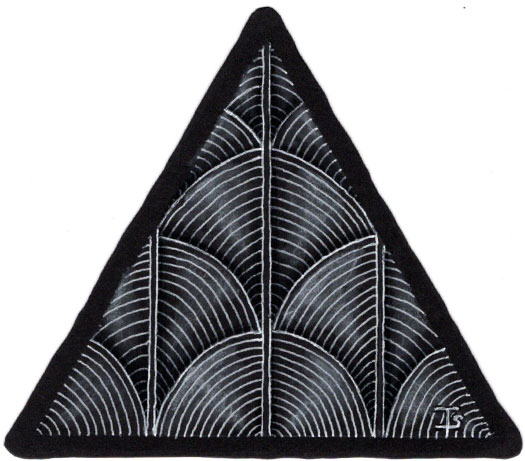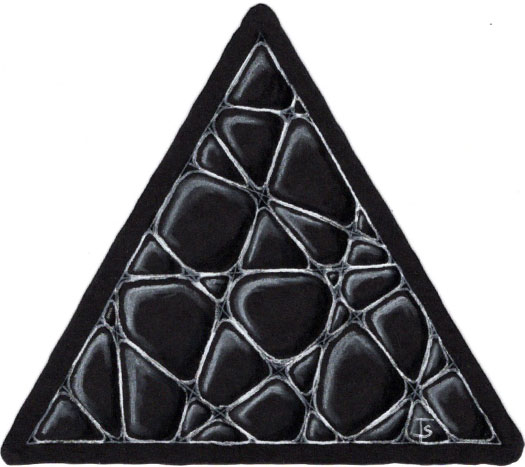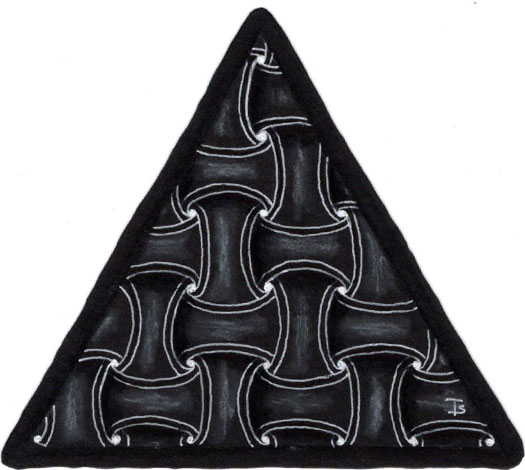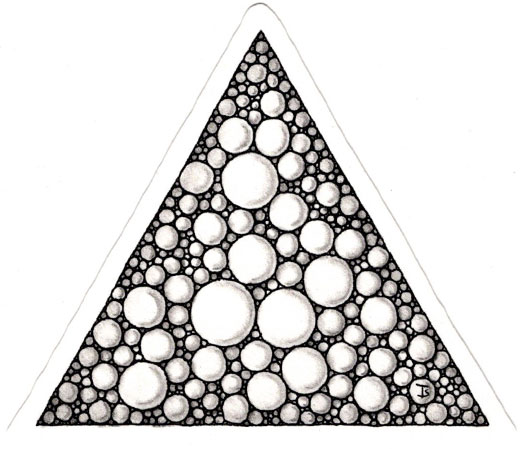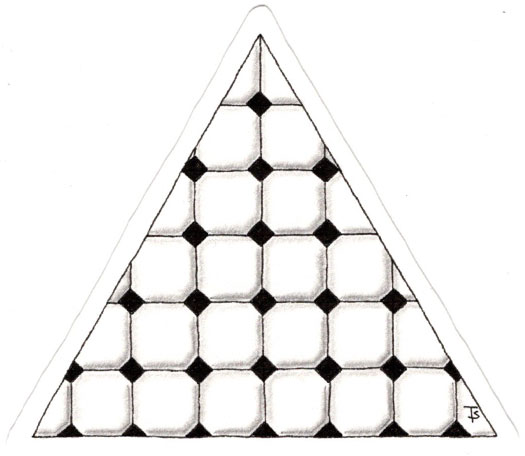PP08 - Day 8 - The Last Day, The Last Project
In the final video for Project Pack 8, Maria takes us through creating a hexigonal design created using six 3Z tiles.
While all these tiles appear the same at first glance, there are two different center designs, three tiles with the “arms” of the center going clockwise and three with the “arms” of the center going counter clockwise. The direction of the tiles alternates going around the hexigon.
It’s interesting, when you create a monotangle, what meta patterns appear over the tile.
Here, because the basic tangle was executed across a triangular grid, circular, flower-like designs end up in the corners and sunken, shield-type shapes are offset across the tile!
I chose to add the lines to give the impression of screws in each small circle because I thought it would be more interesting and help break up the design a bit.
It an interesting thing about tangling. Sometimes, an idea doesn’t come out anything like you imagined it would. But it’s still interesting. Just different.
This is the first time I’ve tried this paper. It is fairly stiff and thick, and the surface doesn’t absorb and spread the ink like I thought it would.
It’s also a darker grey than I would have liked. But the darker color makes the pink ink pop!
It was graduation day for my Saturday morning tribe! They created tiles using Renaissance techniques.
I’m so honored that this group allowed me to start them off on their Zentangle adventures. I’m sure I’ll be seeing lots from them in the future!
Zentangle drawn on Official tan 3Z tiles using a black and brown, Micron pens. Shading done with graphite pencil. Highlights created with white chalk pencil.
Tangles: Festune Ravel Striping
A little over a year ago, I posted a tan, 3Z tile with this design . I was looking at it yesterday, and wondered what would happened if I used the same tangles and string, but in a different color?
Here, I’ve tried it in the colors of the Delft Delights tiles. It’s interesting how there are differences and similarities to the previous version!
Zentangle drawn on Strathmore Vellum Bristol 3Z-size tile, using several different blue, Micron pens. Shading and highlights done with colored pencil and gel pen.
Sometimes, we look at a tangle and think “that’s too simple” or “what a boring tangle”. But you shouldn’t take a tangle for granted, just because of it’s simplicity!
Munchin is one of those tangles. I specifically chose it for this monotangle to highlight it’s amazing depth and beauty when done large. Just a little subtle shading and highlighting make it pop right off the tile.
Your challenge, today, is to use Munchin with other tangles on your tile in a way that highlights this simple tangle!
The tangle Waybop lends itself well to the the triangular shape of this tile. It can be tucked into the points quite nicely while still maintaining it’s nature.
Here, pink, grey and white are combined in gel pen to accent the main tangle and then in colored pencil and pale grey Stablo fineliner to create the decorative elements.
Even the pencil shading, added inside the circles and inward pointing elements adds yet another shade of grey. Meanwhile, the subtle pink in the center echoes the colors of the pearls.
I did a grey and pink tile using Indy-Rella a while back, where I used them as fish-like shapes.
Here, I wanted to create the feeling of flames, using metallic markers and going from bright silver to red.
It reminds me of a camp fire, so I think it is a success!
Zentangle drawn on Strathmore, black, ArtRage paper various, metallic, gel pens. Shading done with colored pencil and Copic marker. Highlights created with General’s White Charcoal pencil.
I don’t draw this tangle often enough! I picked it for this 3Z because I woke up thinking about it in the morning. So, I took that as a sign to create this tile.
So, have you been wondering why I’ve created so many 3Z tiles? Stay tuned!
Zentangle drawn on Strathmore Vellum Bristol using a black, Micron pen. Shading done with graphite pencil. Highlights created with white colored pencil.
Crazy Huggins is a tangle that I often turn to when I’m not sure what to do. It’s fun to draw, has a wonderful, meditative rhythm and allows for all different kinds of variation.
I recently did a version of regular Huggins on a black tile, with no extra embellishment that you can compare to this one by clicking on the link.
If you want to see even more examples, going all the way back to 2017, click here .
I call this my “Ode to Frida” monotangle. That’s becauseit reminds me of those large flowers that she often wore in her hair, like a crown.
This version of Diva Dance produces strong, graphic, circular elements. So I chose to draw them in three different colors. I like the contrast between the brown, black and white inks.
I also chose not to add any graphite or other shading. I feel that this is one of the few cases where it could detract from the over-all design.
“In typography, a dingbat is an ornament, character, or spacer used in typesetting, often employed for the creation of box frames.” - Wikipedia
We’ve all seen them decorating title pages, the ends of paragraphs or other areas of printed books.
Zentangle, and CZT Brian Crimmins in particular, has created a tangled version of this classic concept. It is called Dingbatz, in honor of it’s typographical cousin. Here, we use the stylistic shapes and concepts of the original, but employ tangles as graphical elements.
This the tangle on this 3Z monotangle is "Wheelz", by Joyce Block . If you click on the link, you can see her step-out for it. Just as any tangler, the way I draw it reflects my style, but you will see that mine is close to the original. It is similar to the tangle “Rixty”, by Zentangle.
I love the way this tangle kind of grows, as you draw it. Depending on where you choose to place each element, and how far apart the elements are, it can remind the viewer of a flower or a spiral or berries or seed pods! It’s a wonderful, organic fill, or can be used as a border or divider between other tangles.
I love tangling on tan! It opens the door to so many different and interesting possiblities. And I never know how it will actually turn out.
This was inspired by another Zentangle that I did last year. But I wanted to change it up some, and recreate it on a triangular tile.
Although it didn’t show up well on the scan, I used gold ink on top of the black band on the border to create a Marasu pattern. And I used a brown pen to draw the Tipple bubbles around the central Verdigogh fronds.
I’ve posted Zentangles with a design similar to this tile before, here and here .
In addition, the other two examples have no shading or highlights. So I needed and example that included these additions.
I’m doing it again because I’m using it on a class project and I wanted it on a 3Z for my students to observe and discuss.
Zentangle drawn on black, Strathmore, Artagain paper using a white, Sakura, gel pen. Shading done with Copic Markers and black colored pencil. Highlighting done with General’s Charcoal White.
For me, this is the traditional way of drawing Shattuck. As an alternative, it could be done with straight lines, instead of curved. I do it both ways, depending on what I am working on.
Zentangle drawn on black, Strathmore, Artagain paper using a white, Sakura, gel pen. Shading done with Copic Markers and black colored pencil. Highlighting done with General’s Charcoal White.
Tangles: Shattuck
One of the things that I love about the “Crazy” versions of various tangles is how forgiving they are for those who struggle with perfection. Crazy ‘Nzeppel is a perfect example. Because each section ends up being a different, and some times surprising shape, each squished bubble doesn’t have to match any other!
Zentangle drawn on black, Strathmore, Artagain paper using a white, Sakura, gel pen. Shading done with Copic Markers and black colored pencil. Highlighting done with General’s Charcoal White.
Huggins is a favorite tangle for many, many people. Here, I’ve chosen to create it in a traditional manner, with added auras inside each shape.
When this was first drawn, it really didn’t look like much. But the addition of shading and highlighting brings it to life!
Zentangle drawn on black, Strathmore, Artagain paper using a white, Sakura, gel pen. Shading done with Copic Markers and black colored pencil. Highlighting done with General’s Charcoal White.
How do you practice drawing orbs? By drawing orbs!
I actually found it very relaxing to draw lots and lots of circles. I tried various methods, both drawing all the way around in one fluid motion and drawing a “C” shape for one side and then the other.
I learned that some sizes I can do very nicely, and some are harder to do. It’s important to turn the tile so that you can see what your doing. It made a big difference!
This deceptively simple tile was so meditative because I took my time with the linework.
A great trick to use, to get the spacing even is to “divide and conquer.” What I mean by that is to begin by dividing the space in half, vertically. Then divide each half in half again. Repeat until you are happy with the divisions.
Then divide the horizontal spaces. In the case of this tangle, they are equal to the width of the vertical divisions, making a square. Or there about.
